Effect of TiO2 Morphology on the Properties and Photocatalytic Activity of g-C3N4/TiO2 Nanocomposites Under Visible-Light Illumination
Abstract
1. Introduction
2. Results and Discussion
2.1. Structural and Chemical Analyses
2.1.1. FTIR Analysis
2.1.2. XRD Analysis
2.1.3. Determination of Porosity of Samples
2.1.4. Other Surface Properties
2.1.5. Investigation of Phase Composition, Morphology, and Crystal Structure
2.2. Optical and Electronic Properties of the Investigated Materials
2.2.1. UV-Vis DR Measurements
2.2.2. Solid-State PL Measurements
2.2.3. Electrochemical Investigation
2.2.4. Solid-State EPR Investigation
2.3. XPS Analysis of Solid Nanomaterials
2.4. Photocatalytic Activity Under Visible-Light Illumination
2.4.1. Photocatalytic Bisphenol A Degradation
2.4.2. In Situ Quenching Experiments
2.5. Discussion of Improved Photocatalytic Activity
Proposed Charge Transfer Mechanism
2.6. Reactive Oxygen Species Scavenging Under Visible-Light Illumination
2.6.1. Determination of Hydroxyl Radical Generation Tendency
2.6.2. EPR Spin Trapping Experiments
3. Experimental Procedure
3.1. Synthesis of Materials
3.2. Structural and Textural Properties of the Materials
3.3. Analysis of the Optical and Electronic Properties of Materials
3.4. XPS Analysis
3.5. Tests of the Photocatalytic Activity and Mechanistic Studies of the Prepared Materials
4. Conclusions
Supplementary Materials
Author Contributions
Funding
Institutional Review Board Statement
Informed Consent Statement
Data Availability Statement
Acknowledgments
Conflicts of Interest
References
- Vaiano, V.; Sacco, O.; Sannino, D. Electric energy saving in photocatalytic removal of crystal violet dye through the simultaneous use of long-persistent blue phosphors, nitrogen-doped TiO2 and UV-light emitting diodes. J. Clean. Prod. 2019, 210, 1015–1021. [Google Scholar] [CrossRef]
- Armaković, S.J.; Savanović, M.M.; Armaković, S. Titanium dioxide as the most used photocatalyst for water purification: An overview. Catalysts 2023, 13, 26. [Google Scholar] [CrossRef]
- Anucha, C.B.; Altin, I.; Bacaksiz, E.; Stathopoulos, V.N. Titanium dioxide (TiO2)-based photocatalyst materials activity enhancement for contaminants of emerging concern (CECs) degradation: In the light of modification strategies. Chem. Eng. J. Adv. 2022, 10, 100262. [Google Scholar] [CrossRef]
- Ismael, M. A review on graphitic carbon nitride (g-C3N4) based nanocomposites: Synthesis, categories, and their application in photocatalysis. J. Alloys Compd. 2020, 846, 156446. [Google Scholar] [CrossRef]
- Cui, X.; Jiang, G.; Zhao, Z.; Xu, C.; Bai, W.; Wang, Y.; Duan, A.; Liu, J.; Wei, Y. Facile regulation of crystalline phases and exposed facets on Ti3+ self-doped TiO2 for efficient photocatalytic hydrogen evolution. J. Mater. Sci. 2016, 51, 10819–10832. [Google Scholar] [CrossRef]
- Qiu, M.; Tian, Y.; Chen, Z.; Yang, Z.; Li, W.; Wang, K.; Wang, L.; Wang, K.; Zhang, W. Synthesis of Ti3+ self-doped TiO2 nanocrystals based on Le Chatelier’s principle and their application in solar light photocatalysis. RSC Adv. 2016, 6, 74376–74383. [Google Scholar] [CrossRef]
- Lincho, J.; Mazierski, P.; Klimczuk, T.; Martins, R.C.; Gomes, J.; Zaleska-Medynska, A. TiO2 nanotubes modification by photodeposition with noble metals: Characterization, optimization, photocatalytic activity, and by-products analysis. J. Environ. Chem. Eng. 2024, 12, 112990. [Google Scholar] [CrossRef]
- Kernazhitsky, L.; Shymanovska, V.; Gavrilko, T.; Naumov, V.; Fedorenko, L.; Kshnyakin, V.; Baran, J. Room temperature photoluminescence of anatase and rutile TiO2 powders. J. Lumin. 2014, 146, 199–204. [Google Scholar] [CrossRef]
- Žerjav, G.; Arshad, M.S.; Djinović, P.; Zavašnik, J.; Pintar, A. Electron trapping energy states of TiO2–WO3 composites and their influence on photocatalytic degradation of bisphenol A. Appl. Catal. B 2017, 209, 273–284. [Google Scholar] [CrossRef]
- Chen, X.; Liu, L.; Huang, F. Black titanium dioxide (TiO2) nanomaterials. Chem. Soc. Rev. 2015, 44, 1861–1885. [Google Scholar] [CrossRef]
- Moreira, N.F.F.; Sampaio, M.J.; Ribeiro, A.R.; Silva, C.G.; Faria, J.L.; Silva, A.M.T. Metal-free g-C3N4 photocatalysis of organic micropollutants in urban wastewater under visible light. Appl. Catal. B 2019, 248, 184–192. [Google Scholar] [CrossRef]
- Ganharul, G.K.Q.; Tofanello, A.; Bonadio, A.; Freitas, A.L.M.; Escote, M.T.; Polo, A.S.; Nantes-Cardoso, I.L.; Souza, J.A. Disclosing the hidden presence of Ti3+ ions in different TiO2 crystal structures synthesized at low temperature and photocatalytic evaluation by methylene blue photobleaching. J. Mater. Res. 2021, 36, 3353–3365. [Google Scholar] [CrossRef]
- Son, A.; Lee, J.; Seid, M.G.; Rahman, E.; Choe, J.; Cho, K.; Lee, J.; Hong, S.W. Ti3+ self-doped TiO2 nanotube arrays revisited as Janus photoelectrodes for persulfate activation and water treatment. Appl. Catal. B 2022, 315, 121543. [Google Scholar] [CrossRef]
- Bai, C.; Yang, D.; Liu, C.; Zhu, F.; Tu, C.; Li, G.; Luo, Y. In situ synthesis NiO@TiO2/MXene as a promoter for ammonium perchlorate based solid propellants. Appl. Surf. Sci. 2024, 652, 159228. [Google Scholar] [CrossRef]
- Zhang, R.; Liu, Y.; Wang, C.; Li, Y.; Zhu, Q.; Zhang, S.; Tian, C.; Sun, X.; Huang, W. Constructing bifunctional TiO2 from NH2-MIL-125(Ti) for excellent photocatalytic tetracycline degradation. J. Alloys Compd. 2023, 965, 171396. [Google Scholar] [CrossRef]
- Wang, Z.; Ren, D.; He, Y.; Hong, M.; Bai, Y.; Jia, A.; Liu, X.; Tang, C.; Gong, P.; Liu, X.; et al. Tailoring electronic properties and atom utilizations of the Pd species supported on anatase TiO2 {101} for efficient CO2 hydrogenation to formic acid. ACS Catal. 2023, 13, 10056–10064. [Google Scholar] [CrossRef]
- Roškarič, M.; Žerjav, G.; Zavašnik, J.; Pintar, A. The influence of synthesis conditions on the visible-light triggered photocatalytic activity of g-C3N4/TiO2 composites used in AOPs. J. Environ. Chem. Eng. 2022, 10, 107656. [Google Scholar] [CrossRef]
- Hao, R.; Wang, G.; Tang, H.; Sun, L.; Xu, C.; Han, D. Template-free preparation of macro/mesoporous g-C3N4/TiO2 heterojunction photocatalysts with enhanced visible light photocatalytic activity. Appl. Catal. B 2016, 187, 47–58. [Google Scholar] [CrossRef]
- Batista, J.A.F.; Mendes, J.; Moretto, W.E.; Quadro, M.S.; Santos, J.H.Z.D.; de Escobar, C.C. Sunlight removal of diclofenac using g-C3N4, g-C3N4/Cl, g-C3N4/Nb2O5 and g-C3N4/TiO2 photocatalysts. J. Environ. Chem. Eng. 2024, 12, 113016. [Google Scholar] [CrossRef]
- Rajeshwari, M.R.; Kokilavani, S.; Khan, S.S. Recent developments in architecturing the g-C3N4 based nanostructured photocatalysts: Synthesis, modifications and applications in water treatment. Chemosphere 2022, 291, 132735. [Google Scholar] [CrossRef]
- Cao, S.; Yu, J. g-C3N4-based photocatalysts for hydrogen generation. J. Phys. Chem. Lett. 2014, 5, 2101–2107. [Google Scholar] [CrossRef] [PubMed]
- Xing, C.; Yu, G.; Zhou, J.; Liu, Q.; Chen, T.; Liu, H.; Li, X. Solar energy-driven upcycling of plastic waste on direct Z-scheme heterostructure of V-substituted phosphomolybdic acid/g-C3N4 nanosheets. Appl. Catal. B 2022, 315, 121496. [Google Scholar] [CrossRef]
- Sharma, M.; Vaidya, S.; Ganguli, A.K. Enhanced photocatalytic activity of g-C3N4-TiO2 nanocomposites for degradation of Rhodamine B dye. J. Photochem. Photobiol. A 2017, 335, 287–293. [Google Scholar] [CrossRef]
- Samsudin, M.F.R.; Bacho, N.; Sufian, S. Recent development of graphitic carbon nitride-based photocatalyst for environmental pollution remediation. In Nanocatalysts; Sinha, I., Shukla, M., Eds.; IntechOpen: London, UK, 2018. [Google Scholar] [CrossRef]
- Kočí, K.; Reli, M.; Troppová, I.; Šihor, M.; Kupková, J.; Kustrowski, P.; Praus, P. Photocatalytic decomposition of N2O over TiO2/g-C3N4 photocatalysts heterojunction. Appl. Surf. Sci. 2017, 396, 1685–1695. [Google Scholar] [CrossRef]
- Wang, Y.; Yu, J.; Peng, W.; Tian, J.; Yang, C. Novel multilayer TiO2 heterojunction decorated by low g-C3N4 content and its enhanced photocatalytic activity under UV, visible and solar light irradiation. Sci. Rep. 2019, 9, 5932. [Google Scholar] [CrossRef]
- Hassan, F.; Bonnet, P.; Dikdim, J.M.D.; Bandjoun, N.G.; Caperaa, C.; Dalhatou, S.; Kane, A.; Zeghioud, H. Synthesis and investigation of TiO2/g-C3N4 performance for photocatalytic degradation of bromophenol blue and eriochrome black T: Experimental design optimization and reactive oxygen species contribution. Water 2022, 14, 3331. [Google Scholar] [CrossRef]
- Liu, H.; Zhang, Z.-G.; He, H.-W.; Wang, X.-X.; Zhang, J.; Zhang, Q.-Q.; Tong, Y.-F.; Liu, H.-L.; Ramakrishna, S.; Yan, S.-Y.; et al. One-step synthesis heterostructured g-C3N4/TiO2 composite for rapid degradation of pollutants in utilizing visible light. Nanomaterials 2018, 8, 842. [Google Scholar] [CrossRef]
- Wang, X.-J.; Yang, W.-Y.; Li, F.-T.; Xue, Y.-B.; Liu, R.-H.; Hao, Y.-J. In situ microwave-Assisted Synthesis of Porous N-TiO2/g-C3N4 Heterojunctions with Enhanced Visible-Light Photocatalytic Properties. Ind. Eng. Chem. Res. 2013, 52, 17140–17150. [Google Scholar] [CrossRef]
- Jo, W.-K.; Natarajan, T.S. Influence of TiO2 morphology on the photocatalytic efficiency of direct Z-scheme g-C3N4/TiO2 photocatalysts for isoniazid degradation. Chem. Eng. J. 2015, 281, 549–565. [Google Scholar] [CrossRef]
- Roškarič, M.; Zavašnik, J.; Zámbó, D.; Kotnik, T.; Kovačič, S.; Žerjav, G.; Pintar, A. Optimization method based on simplex for surface area improved photocatalytic performance of g-C3N4. ACS Catal. 2023, 13, 13282–13300. [Google Scholar] [CrossRef]
- Wang, L.; Fei, X.; Zhang, L.; Yu, J.; Cheng, B.; Ma, Y. Solar fuel generation over nature-inspired recyclable TiO2/g-C3N4 S-scheme hierarchical thin-film photocatalyst. J. Mater. Sci. Technol. 2022, 112, 1–10. [Google Scholar] [CrossRef]
- Yang, L.; Jia, F.; Juan, Z.; Yu, D.; Sun, L.; Song, Y.; Wang, Y.; Huang, L.; Tang, J. High-permeable graphene oxide/graphitic carbon nitride composite nanofiltration membrane for selective separation of dye and desalination. J. Environ. Chem. Eng. 2023, 11, 109306. [Google Scholar] [CrossRef]
- Kumar, P.S.; Prakash, P. Metal free nanocomposite of graphitic carbon nitride, boron nitride and chitosan for efficient evolution of hydrogen: A strategic approach to achieving sustainable and effective electrocatalysis. J. Environ. Chem. Eng. 2023, 11, 109045. [Google Scholar] [CrossRef]
- Li, J.; Zhang, M.; Li, Q.; Yang, J. Enhanced visible light activity on direct contact Z-scheme g-C3N4-TiO2 photocatalyst. Appl. Surf. Sci. 2017, 391, 184–193. [Google Scholar] [CrossRef]
- Roškarič, M.; Žerjav, G.; Finšgar, M.; Zavašnik, J.; Pintar, A. Influence of the calcination duration of g-C3N4/TiO2 “veggie-toast-like” photocatalyst on the visible-light triggered photocatalytic oxidation of bisphenol A. J. Alloys Compd. 2023, 947, 169585. [Google Scholar] [CrossRef]
- Palmisano, L.; Augugliaro, V.; Schiavello, M.; Sclafani, A. Influence of acid-base properties on photocatalytic and photochemical processes. J. Mol. Catal. 1989, 56, 284–295. [Google Scholar] [CrossRef]
- Zhu, B.; Xia, P.; Ho, W.; Yu, J. Isoelectric point and adsorption activity of porous g-C3N4. Appl. Surf. Sci. 2015, 344, 188–195. [Google Scholar] [CrossRef]
- Shang, Q.; Gao, S.; Dai, G.; Ren, J.; Wang, D. Structure and photocatalytic activity of Ti3+ self-doped TiO2 flower shaped nanospheres. Surf. Interfaces 2020, 18, 100426. [Google Scholar] [CrossRef]
- Valentin, C.D.; Pacchioni, G.; Selloni, A. Reduced and n-type doped TiO2: Nature of Ti3+ species. J. Phys. Chem. C 2009, 113, 20543–22052. [Google Scholar] [CrossRef]
- Aïnouche, L.; Hamadou, L.; Kadri, A.; Benbrahim, N.; Bradai, D. Ti3+ states induced band gap reduction and enhanced visible light absorption of TiO2 nanotube arrays: Effect of the surface solid fraction factor. Sol. Energ. Mat. Sol. C 2016, 151, 179–190. [Google Scholar] [CrossRef]
- Xu, Y.; Wu, S.; Wan, P.; Sun, J.; Hood, Z.D. Introducing Ti3+ defects based on lattice distortion for enhanced visible light photoreactivity in TiO2 microspheres. RSC Adv. 2017, 7, 32461–32467. [Google Scholar] [CrossRef]
- Abazović, N.D.; Čomor, M.I.; Dramićanin, M.D.; Jovanović, D.J.; Ahrenkiel, S.P.; Nedeljković, J.M. Photoluminescence of anatase and rutile TiO2 particles. J. Phys. Chem. B 2006, 110, 25366–25370. [Google Scholar] [CrossRef] [PubMed]
- Daude, N.; Gout, C.; Jouanin, C. Electronic band structure of titanium dioxide. Phys. Rev. B 1977, 15, 3229. [Google Scholar] [CrossRef]
- Liqiang, J.; Yichun, Q.; Baiqi, W.; Shudan, L.; Baojiang, J.; Libin, Y.; Wei, F.; Honggang, F.; Jiazhong, S. Review of photoluminescence performance of nano-sized semiconductor materials and its relationships with photocatalytic activity. Sol. Energy Mater. Sol. Cells 2006, 90, 1773–1787. [Google Scholar] [CrossRef]
- Liu, S.; Yuan, S.; Zhang, Q.; Xu, B.; Wang, C.; Zhang, M.; Ohno, T. Fabrication and characterization of black TiO2 with different Ti3+ concentrations under atmospheric conditions. J. Catal. 2018, 366, 282–288. [Google Scholar] [CrossRef]
- Sun, X.; Wu, J.; Tian, F.; Zhang, W.; Li, Q. Synergistic effect of surface defect and interface heterostructure on TiO2/BiOIO3 photocatalytic oxide gas-phase mercury. Mater. Res. Bull. 2018, 103, 247–258. [Google Scholar] [CrossRef]
- Das, D.; Shinde, S.L.; Nanda, K.K. Temperature-dependent photoluminescence of g-C3N4: Implication for temperature sensing. ACS Appl. Mater. Interfaces 2016, 8, 2181–2186. [Google Scholar] [CrossRef]
- Abdel-Mageed, A.M.; Wiese, K.; Hauble, A.; Bansmann, J.; Rabeah, J.; Parlinska-Wojtan, M.; Brückner, A.; Behm, R.J. Steering the selectivity in CO2 reduction on highly active Ru/TiO2 catalysts: Support particle size effects. J. Catal. 2021, 401, 160–173. [Google Scholar] [CrossRef]
- Kokorin, A.I.; Bahnemann, D. Chemical Physics of Nanostructured Semiconductors; Taylor & Francis Group: Utrecht, The Netherlands; Boston, MA, USA, 2003; pp. 1–34. [Google Scholar] [CrossRef]
- Makmi, H.E.; Deroide, B.; Bensimon, Y.; Zanchetta, J.V. Paramagnetic defects in solid sulphur and glasses of the system Ge–S. J. Non-Cryst. Solids 2001, 291, 78–85. [Google Scholar] [CrossRef]
- Xiong, L.-B.; Li, J.-L.; Yang, B.; Yu, Y. Ti3+ in the surface of titanium dioxide: Generation, properties and photocatalytic application. J. Nanomater. 2011, 2012, 831524. [Google Scholar] [CrossRef]
- Kobkeatthawin, T.; Trakulmututa, J.; Amornsakchai, T.; Kajitvichyanukul, P.; Smith, S.M. Identification of active species in photodegradation of aqueous imidacloprid over g-C3N4/TiO2 nanocomposites. Catalysts 2022, 12, 120. [Google Scholar] [CrossRef]
- Al-Madanat, O.; Nunes, B.N.; Salka, Y.A.; Hakki, A.; Curti, M.; Patrocinio, A.O.T.; Bahnemann, D.W. Application of EPR spectroscopy in TiO2 and Nb2O5 photocatalysis. Catalysts 2021, 11, 1514. [Google Scholar] [CrossRef]
- Dvoranová, D.; Mazúr, M.; Papailias, I.; Giannakopoulou, T.; Trapalis, C.; Brezová, V. EPR investigations of g-C3N4/TiO2 nanocomposites. Catalysts 2018, 8, 47. [Google Scholar] [CrossRef]
- Zahwa, I.; Mouyane, M.; Kassas, A.; Kamlo, A.N.; Moslah, C.; Navas, J.; Livraghi, S.; Bernard, J.; Falah, J.E.; Toufaily, J.; et al. Flash combustion synthesis using two different fuels and characterization of LiF-doped TiO2 for the photocatalytic applications. Open Ceram. 2024, 17, 100562. [Google Scholar] [CrossRef]
- Livraghi, S.; Chiesa, M.; Paganini, M.C.; Giamello, E. On the nature of reduced states in titanium dioxide as monitored by electron paramagnetic resonance. I: The anatase case. J. Phys. Chem. C 2011, 115, 25413–25421. [Google Scholar] [CrossRef]
- Coronado, J.M.; Maira, A.J.; Conesa, J.C.; Yeung, K.L.; Augugliaro, V.; Soria, J. EPR study of the surface characteristics of nanostructured TiO2 under UV irradiation. Langmuir 2001, 17, 5368–5374. [Google Scholar] [CrossRef]
- Abdel-Mageed, A.M.; Wiese, K.; Parlinska-Wojtan, M.; Rabeah, J.; Brückner, A.; Behm, R.J. Encapsulation of Ru nanoparticles: Modifying the reactivity toward CO and CO2 methanation on highly active Ru/TiO2 catalysts. Appl. Catal. B 2020, 270, 118846. [Google Scholar] [CrossRef]
- Yang, D.; Liu, H.; Zheng, Z.; Yuan, Y.; Zhao, J.-C.; Waclawik, E.R.; Ke, X.; Zhu, H. An efficient photocatalyst structure: TiO2(B) nanofibers with a shell of anatase nanocrystals. J. Am. Chem. Soc. 2009, 131, 17885–17893. [Google Scholar] [CrossRef]
- Yurdakal, S.; Çetinkaya, S.; Augugliaro, V.; Palmisano, G.; Soria, J.; Sanz, J.; Torralvo, M.J.; Livraghi, S.; Giamello, E.; Garlisi, C. Alkaline treatment as a means to boost the activity of TiO2 in selective photocatalytic processes. Catal. Sci. Technol. 2020, 10, 5000–5012. [Google Scholar] [CrossRef]
- Kobkeatthawin, T.; Chaveanghong, S.; Trakulmututa, J.; Amornsakchai, T.; Kajitvichyanukul, P.; Smith, S.M. Photocatalytic activity of TiO2/g-C3N4 nanocomposites for removal of monochlorophenols from water. Nanomaterials 2022, 12, 2852. [Google Scholar] [CrossRef] [PubMed]
- Livraghi, S.; Chierotti, M.R.; Giamello, E.; Magnacca, G.; Paganini, M.C.; Cappelletti, G.; Bianchi, C.L. Nitrogen-doped titanium dioxide active in photocatalytic reactions with visible light: A multi-technique characterization of differently prepared materials. J. Phys. Chem. C 2008, 112, 17244–17252. [Google Scholar] [CrossRef]
- Livraghi, S.; Votta, A.; Paganini, M.C.; Giamello, E. The nature of paramagnetic species in nitrogen doped TiO2 active in visible light photocatalysis. Chem. Commun. 2005, 4, 498–500. [Google Scholar] [CrossRef] [PubMed]
- Livraghi, S.; Paganini, M.C.; Giamello, E.; Selloni, A.; Valentin, C.D.; Pacchioni, G. Origin of photoactivity of nitrogen-doped titanium dioxide under visible light. J. Am. Chem. Soc. 2006, 128, 15666–15671. [Google Scholar] [CrossRef]
- Indra, A.; Beltrán-Suito, R.; Müller, M.; Sivasankaran, R.P.; Schwarze, M.; Acharjya, A.; Pradhan, B.; Hofkens, J.; Brückner, A.; Thomas, A.; et al. Promoting photocatalytic hydrogen evolution activity of graphitic carbon nitride with hole-transfer agents. ChemSusChem 2021, 14, 306–312. [Google Scholar] [CrossRef]
- Posada-Borbón, A.; Bosio, N.; Grönbeck, H. On the signatures of oxygen vacancies in O1s core level shifts. Surf. Sci. 2021, 705, 121761. [Google Scholar] [CrossRef]
- Ren, L.; Zhu, W.; Li, Y.; Lin, X.; Xu, H.; Sun, F.; Lu, C.; Zou, J. Oxygen vacancy-rich 2D TiO2 nanosheets: A bridge toward high stability and rapid hydrogen storage kinetics of nano-confined MgH2. Nanomicro Lett. 2022, 14, 144. [Google Scholar] [CrossRef]
- Soto-Vázquez, L.; Rolón-Delgado, F.; Rivera, K.; Cotto, M.C.; Ducongé, J.; Morant, C.; Pinilla, S.; Márquez-Linares, F.M. Catalytic use of TiO2 nanowires in the photodegradation of Benzophenone-4 as an active ingredient in sunscreens. J. Environ. Manage. 2019, 247, 822–828. [Google Scholar] [CrossRef] [PubMed]
- He, M.; Cao, Y.; Ji, J.; Li, K.; Huang, H. Superior catalytic performance of Pd-loaded oxygen-vacancy-rich TiO2 for formaldehyde oxidation at room temperature. J. Catal. 2021, 396, 122–135. [Google Scholar] [CrossRef]
- Sutar, R.S.; Barkul, R.P.; Delekar, S.D.; Patil, M.K. Sunlight assisted photocatalytic degradation of organic pollutants using g-C3N4-TiO2 nanocomposites. Arab. J. Chem. 2020, 13, 4966–4977. [Google Scholar] [CrossRef]
- Hazaraimi, M.H.; Goh, P.S.; Wang, L.Y.; Lau, W.J.; Subramaniam, M.N.; Ismail, A.F.; Hashim, N.; Kerisnan, N.D.; Yahaya, N.K.E.M.; Mamat, R.B.R. Multifunctional roles of g-C3N4 in synthesizing N-TiO2/g-C3N4 heterojunction photocatalyst for photodegradation of bisphenol A. Arab. J. Sci. Eng. 2024. [CrossRef]
- Gao, Z.; Zhang, D.; Jun, Y.-S. Does Tert-butyl alcohol really terminate the oxidative activity of •OH in inorganic redox chemistry? Environ. Sci. Technol. 2021, 55, 10422–10450. [Google Scholar] [CrossRef] [PubMed]
- Xu, Q.; Zhang, L.; Yu, J.; Wageh, S.; Al-Ghamdi, A.A.; Jaroniec, M. Direct Z-scheme photocatalysts: Principles, synthesis, and applications. Mater. Today 2018, 21, 1042–1063. [Google Scholar] [CrossRef]
- Ren, B.; Wang, T.; Qu, G.; Deng, F.; Liang, D.; Yang, W.; Liu, M. In situ synthesis of g-C3N4/TiO2 heterojunction nanocomposites as a highly active photocatalyst for the degradation of Orange II under visible light irradiation. Environ. Sci. Pollut. Res. 2018, 25, 19122–19133. [Google Scholar] [CrossRef] [PubMed]
- Ma, X.; Liu, X.; Zhang, X.; Piao, C.; Liu, Z.; Fang, D.; Wang, J. Construction of dual Z-scheme NiO/NiFe2O4/Fe2O3 photocatalyst via incomplete solid state chemical combustion reactions for organic pollutant degradation with simultaneous hydrogen production. Int. J. Hydrogen Energy 2021, 46, 31659–31673. [Google Scholar] [CrossRef]
- Kumar, R.; Sudhaik, A.; Khan, A.A.P.; Raizada, P.; Asiri, A.M.; Mohapatra, S.; Thakur, S.; Thakur, V.K.; Singh, P. Current status on designing of dual Z-scheme photocatalysts for energy and environmental applications. J. Ind. Eng. Chem. 2022, 106, 340–355. [Google Scholar] [CrossRef]
- Cui, Y.; Nengzi, L.-C.; Gou, J.; Huang, Y.; Li, B.; Cheng, X. Fabrication of dual Z-scheme MIL-53(Fe)/α-Bi2O3/g-C3N4 ternary composite with enhanced visible light photocatalytic performance. Sep. Purif. Technol. 2020, 232, 115959. [Google Scholar] [CrossRef]
- Kang, J.; Jin, C.; Li, Z.; Wang, M.; Chen, Z.; Wang, Y. Dual Z-scheme MoS2/g-C3N4/Bi24O31Cl10 ternary heterojunction photocatalysts for enhanced visible-light photodegradation of antibiotic. J. Alloys Compd. 2020, 825, 153975. [Google Scholar] [CrossRef]
- Wang, K.; Xing, Z.; Du, M.; Zhang, S.; Li, Z.; Pan, K.; Zhou, W. Hollow MoSe2@Bi2S3/CdS core-shell nanostructure as dual Z-scheme heterojunctions with enhanced full spectrum photocatalytic-photothermal performance. Appl. Catal. B 2021, 281, 119482. [Google Scholar] [CrossRef]
- Zhang, D.; Yang, Z.; Hao, J.; Zhang, T.; Sun, Q.; Wang, Y. Boosted charge transfer in dual Z-scheme BiVO4@ZnIn2S4/Bi2Sn2O7 heterojunctions: Towards superior photocatalytic properties for organic pollutant degradation. Chemosphere 2021, 276, 130226. [Google Scholar] [CrossRef]
- Kusutaki, T.; Katsumata, H.; Tateshi, I.; Furukawa, M.; Kaneco, S. Ternary dual Z-scheme graphitic carbon nitride/ultrathin metal–organic framework nanosheet/Ag3PO4 photocatalysts for boosted photocatalytic performance under visible light. RSC Adv. 2019, 9, 39843–39853. [Google Scholar] [CrossRef] [PubMed]
- Liu, W.; Shen, J.; Yang, X.; Liu, Q.; Tang, H. Dual Z-scheme g-C3N4/Ag3PO4/Ag2MoO4 ternary composite photocatalyst for solar oxygen evolution from water splitting. Appl. Surf. Sci. 2018, 456, 369–378. [Google Scholar] [CrossRef]
- Tian, L.; Yang, X.; Cui, X.; Liu, Q.; Tang, H. Fabrication of dual direct Z-scheme g-C3N4/MoS2/Ag3PO4 photocatalyst and its oxygen evolution performance. Appl. Surf. Sci. 2019, 463, 9–17. [Google Scholar] [CrossRef]
- Li, X.; Garlisi, C.; Guan, Q.; Anwer, S.; Al-Ali, K.; Palmisano, G.; Zheng, L. A review of material aspects in developing direct Z-scheme photocatalysts. Mater. Today 2021, 47, 75–107. [Google Scholar] [CrossRef]
- Dvoranová, D.; Barbieriková, Z.; Brezová, V. Radical intermediates in photoinduced reactions on TiO2 (an EPR spin trapping study). Molecules 2014, 19, 17279–17304. [Google Scholar] [CrossRef]
- Khachatryan, L.; Vejerano, E.; Lomnicki, S.; Dellinger, B. Environmentally persistent free radicals (EPFRs). 1. Generation of reactive oxygen species in aqueous solutions. Environ. Sci. Technol. 2011, 45, 8559–8566. [Google Scholar] [CrossRef] [PubMed]

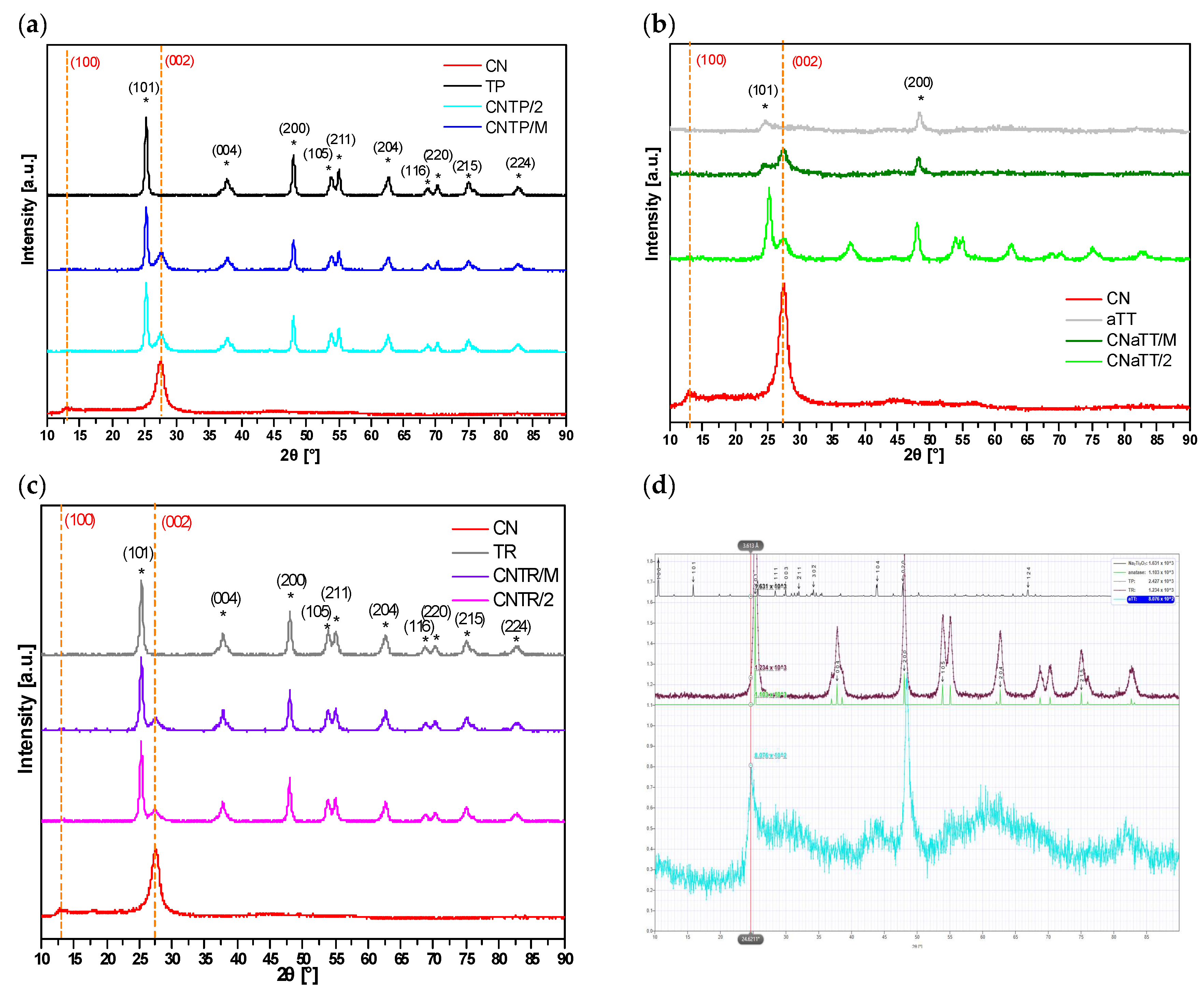
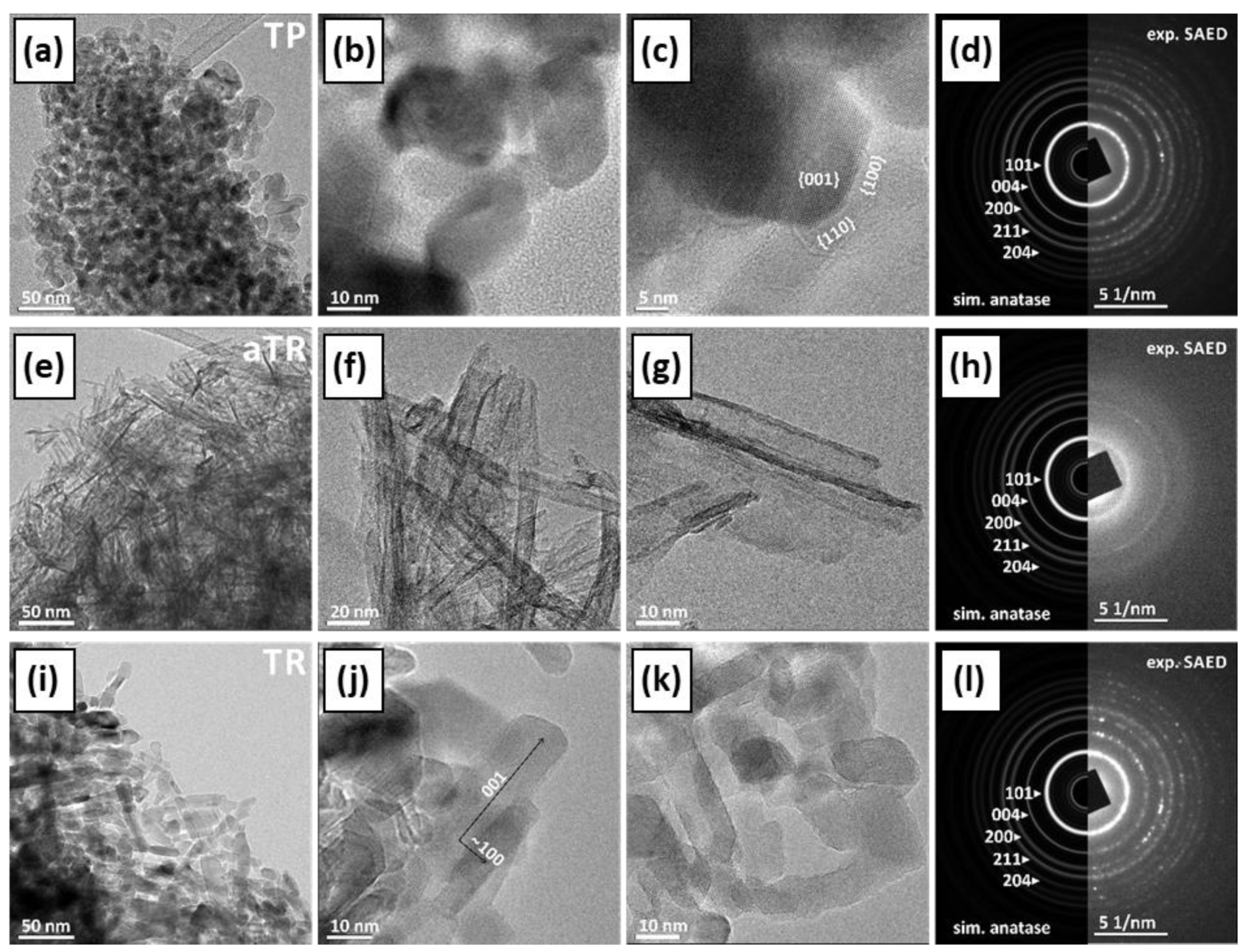
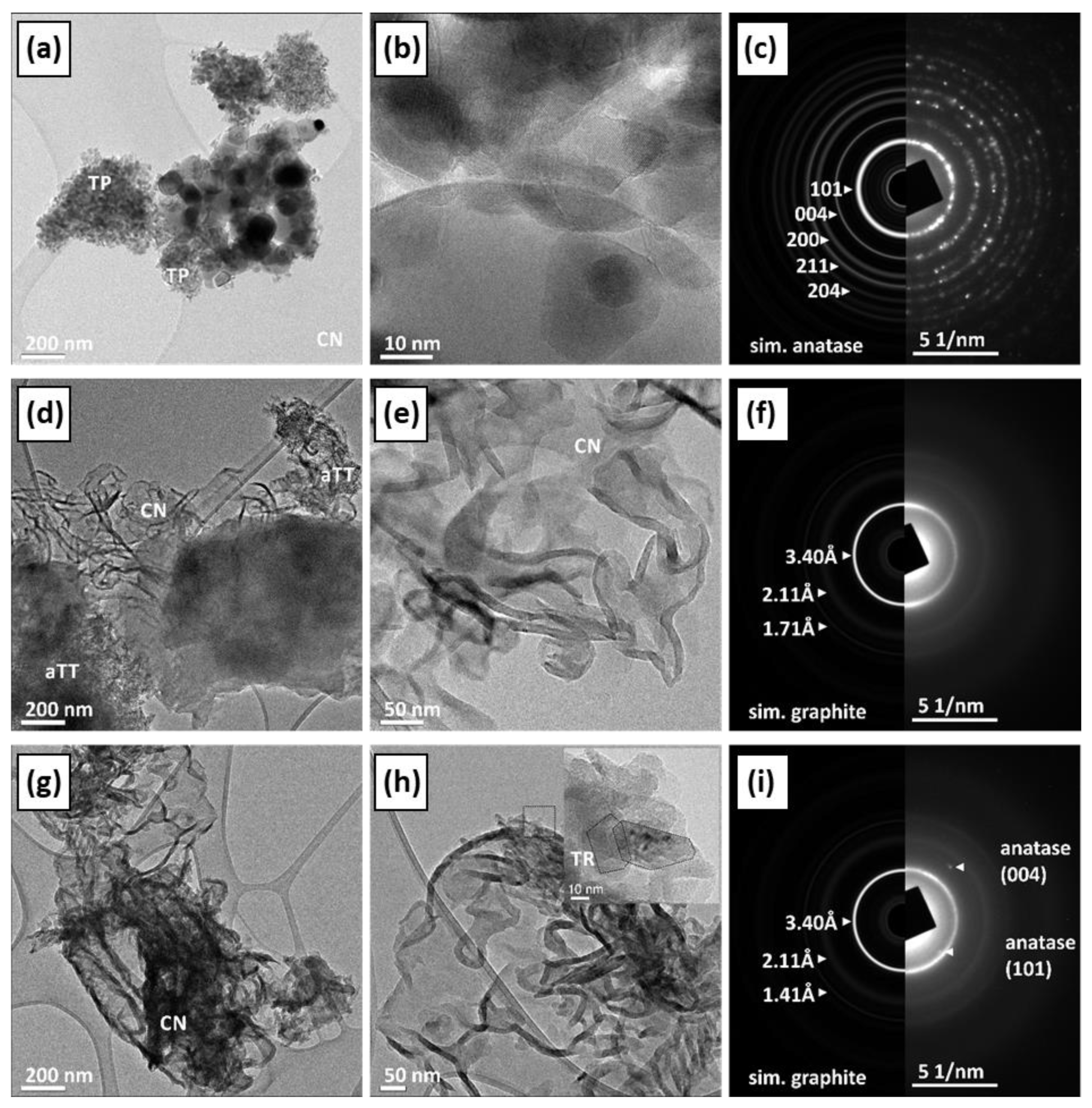
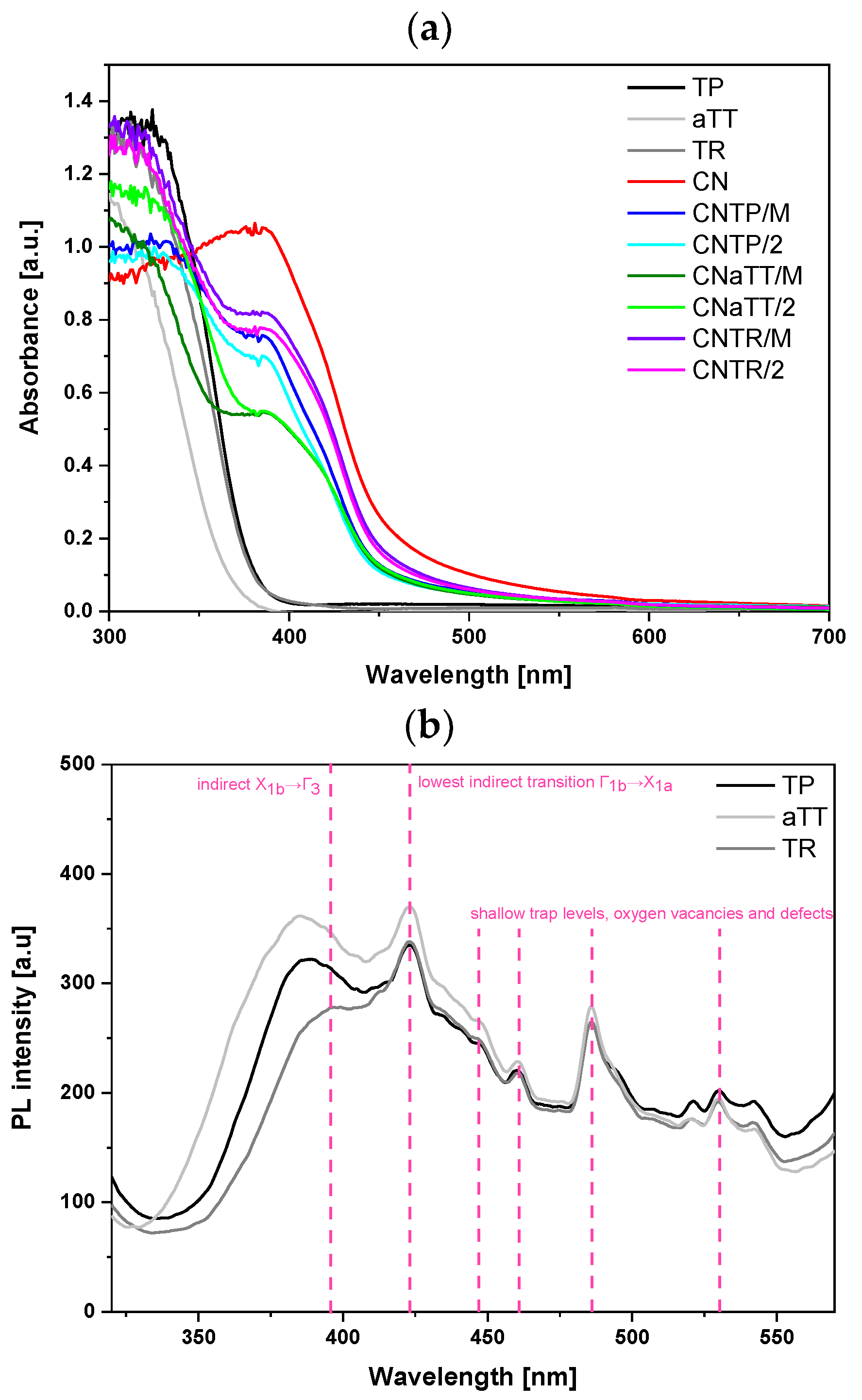
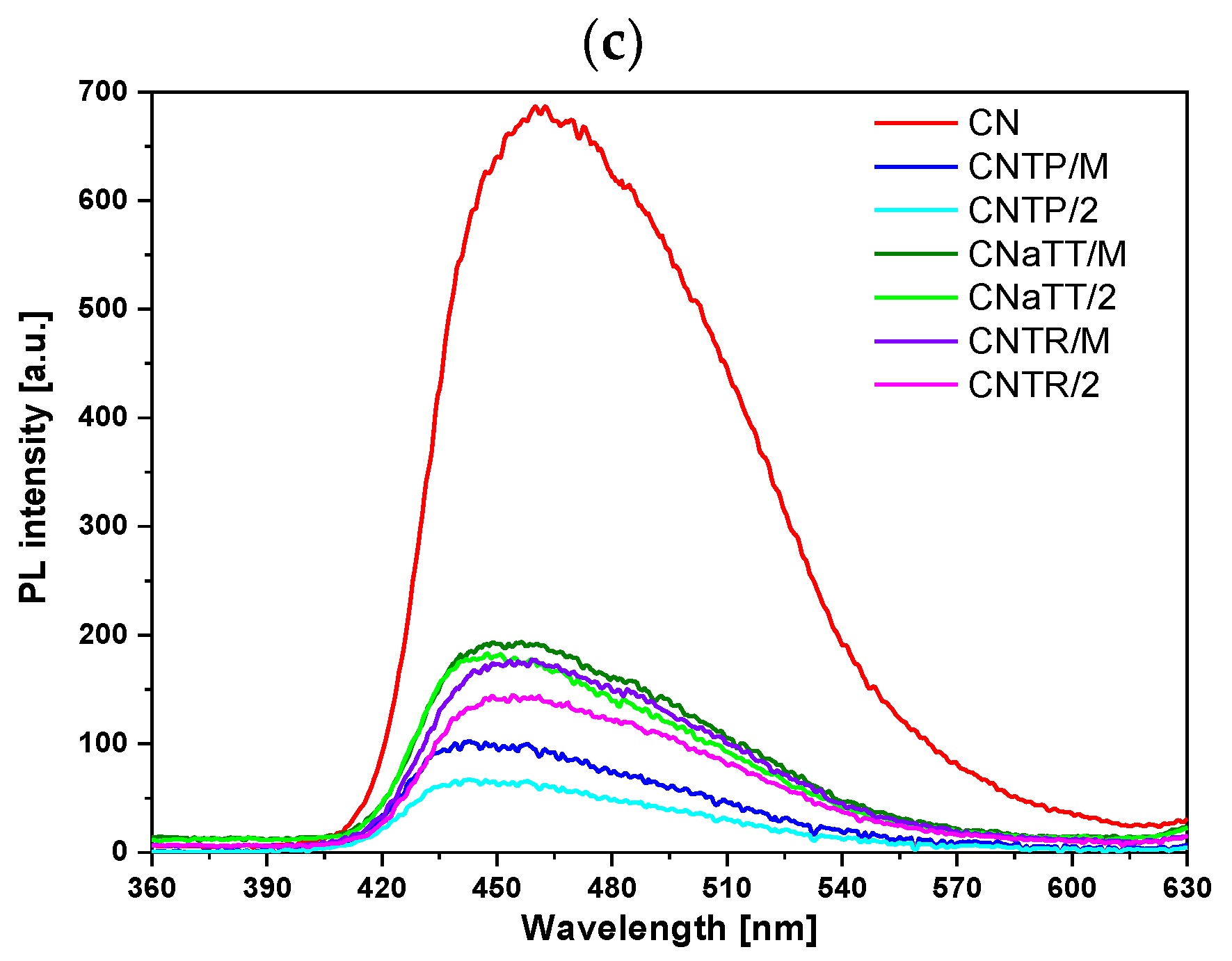
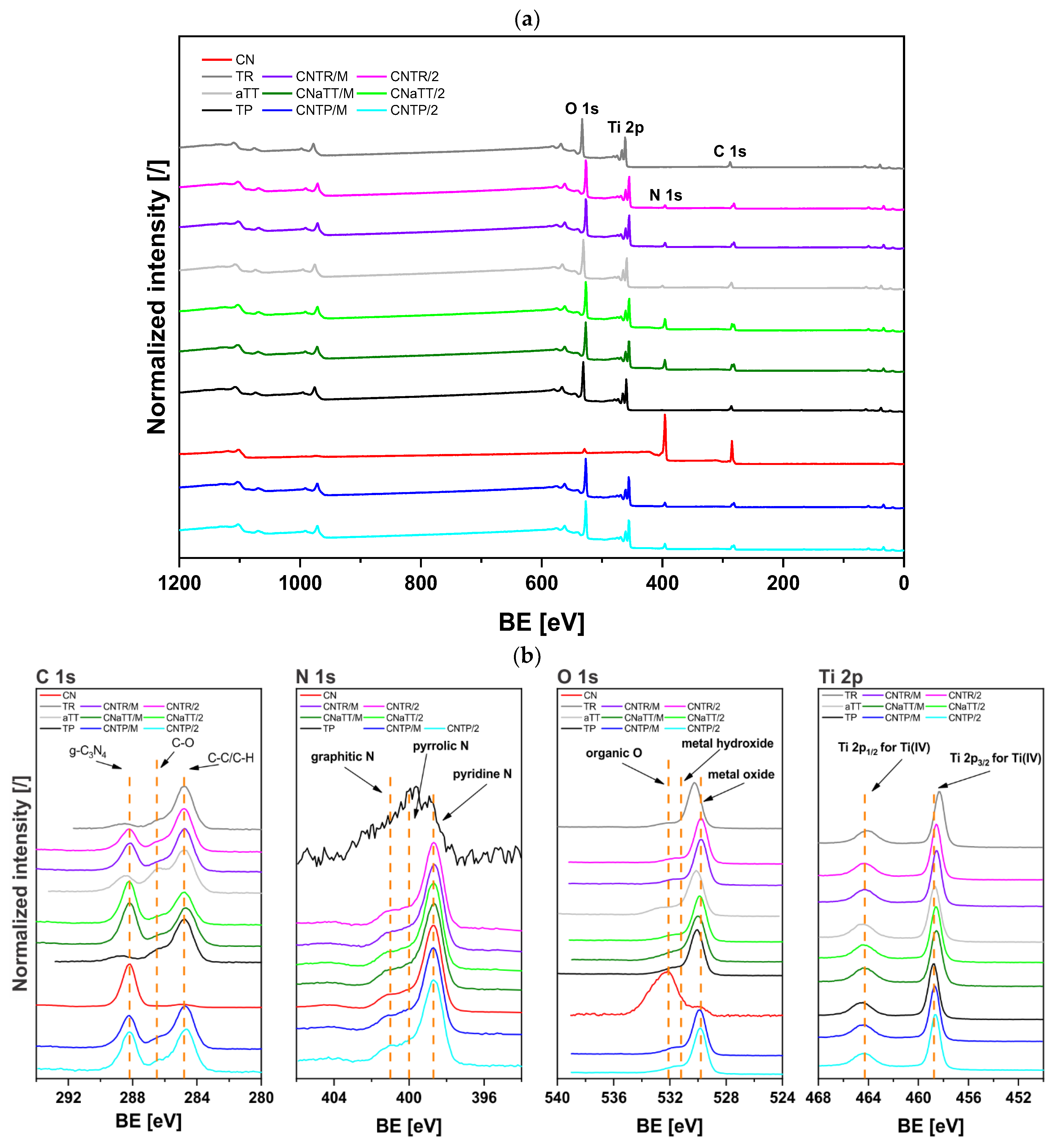
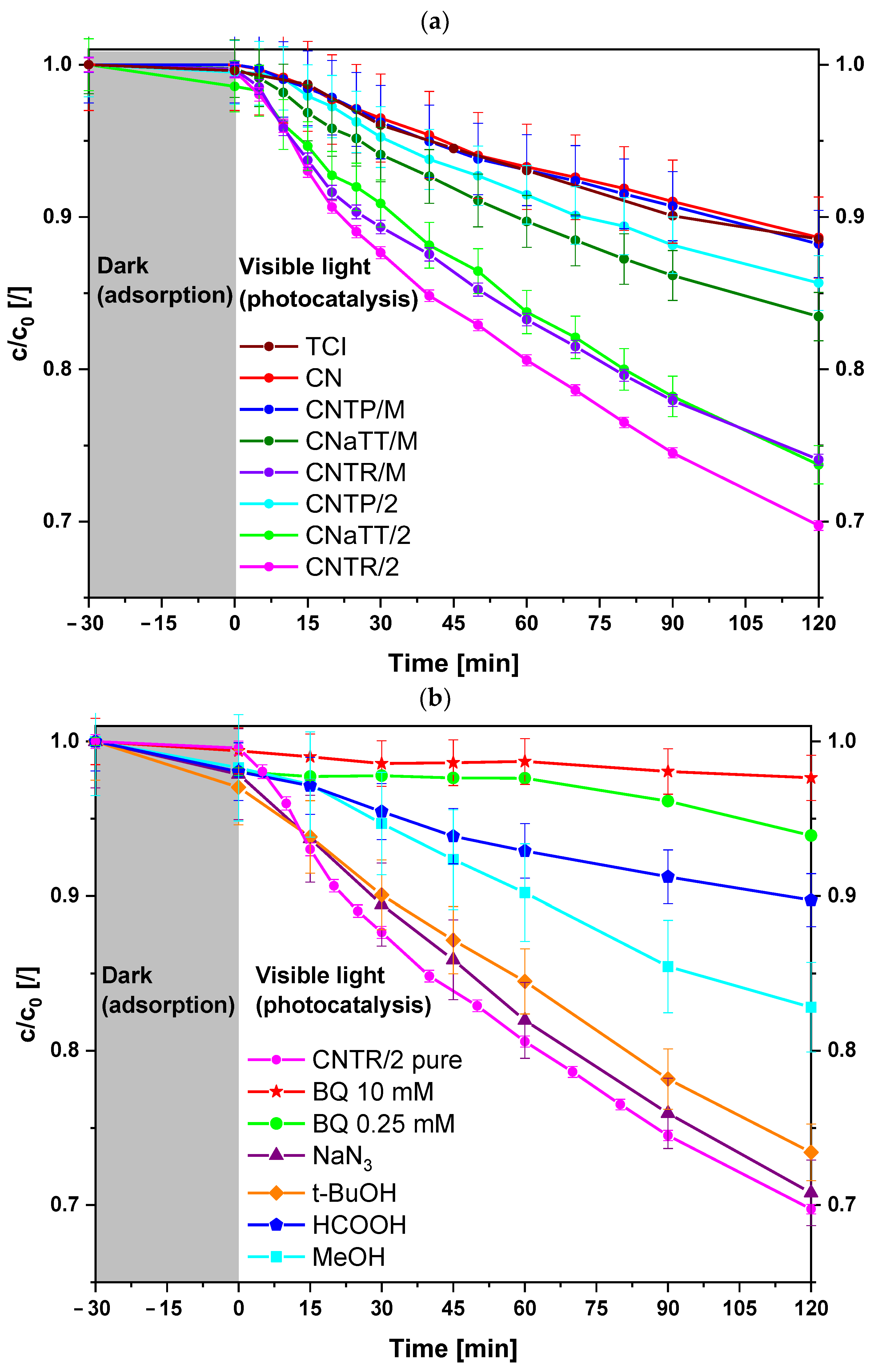

| Sample | SBET | Vpore | dpore | Crystallite Size @ 48° 2θ | CN peak Position of (002) |
|---|---|---|---|---|---|
| m2/g | cm3/g | nm | nm | ° 2θ | |
| CN | 17 ± 1 | 0.08 ± 0.01 | 20.4 ± 0.02 | / | 27.661 |
| TP | 82 ± 1 | 0.29 ± 0.01 | 13.7 ± 0.01 | 18.6 ± 0.1 | / |
| CNTP/M | 57 ± 1 | 0.23 ± 0.02 | 16.8 ± 0.03 | 22.4 ± 0.2 | 27.660 |
| CNTP/2 | 50 ± 1 | 0.21 ± 0.01 | 15.9 ± 0.01 | 22.4 ± 0.1 | 27.595 |
| aTT | 337 ± 6 | 0.99 ± 0.04 | 11.7 ± 0.04 | / | / |
| CNaTT/M | 164 ± 3 | 0.51 ± 0.02 | 12.6 ± 0.02 | / | 27.529 |
| CNaTT/2 | 163 ± 3 | 0.50 ± 0.01 | 12.4 ± 0.01 | 13.7 ± 0.5 | 27.463 |
| TR | 100 ± 2 | 0.47 ± 0.02 | 18.9 ± 0.03 | 22.4 ± 0.1 | / |
| CNTR/M | 57 ± 1 | 0.26 ± 0.01 | 18.2 ± 0.01 | 22.4 ± 0.2 | 27.562 |
| CNTR/2 | 53 ± 1 | 0.24 ± 0.01 | 18.3 ± 0.02 | 22.0 ± 0.1 | 27.496 |
| Sample | a TOCremoval | a TOCM | a TOCA | BPA Degradation |
|---|---|---|---|---|
| % | ||||
| CN | 8.6 | 7.8 | 0.8 | 11.4 ± 0.2 |
| TP | 0.8 | 0.7 | 0.2 | 2.4 ± 0.0 |
| CNTP/M | 10.1 | 8.7 | 1.4 | 11.8 ± 0.2 |
| CNTP/2 | 13.2 | 11.3 | 1.9 | 14.3 ± 0.2 |
| aTT | 1.1 | 0.6 | 0.5 | 2.5 ± 0.0 |
| CNaTT/M | 15.5 | 14.1 | 1.4 | 16.5 ± 0.2 |
| CNaTT/2 | 25.1 | 22.9 | 2.2 | 26.3 ± 0.2 |
| TR | 2.6 | 2.4 | 0.2 | 4.0 ± 0.0 |
| CNTR/M | 24.9 | 23.6 | 1.3 | 26.0 ± 0.1 |
| CNTR/2 | 27.1 | 25.4 | 1.7 | 30.3 ± 0.1 |
| Photocatalyst | Catalysts Dosage | C0(BPA) | BPA Degr. | Light Source | Ref. |
|---|---|---|---|---|---|
| mg/L | mg/L | % | |||
| g-C3N4/TiO2 * | 0.125 | 10 | 21.5 | 150 W, Halogen lamp | [36] |
| TiO2 ** | 0.125 | 10 | 9.0 | ||
| g-C3N4 | 0.125 | 10 | 11.4 | ||
| g-C3N4/TiO2 | 0.5 | 20 | 38.0 | sunlight | [71] |
| TiO2 | 0.5 | 20 | 30.0 | ||
| g-C3N4 | 0.5 | 20 | 25.0 | ||
| g-C3N4/TiO2 * | 0.5 | 10 | 25.0 | 200 W, LED Flood light | [72] |
| TiO2 *** | 0.5 | 10 | 25.0 | ||
| g-C3N4/TiO2 * | 0.125 | 10 | 30.3 | 150 W, Halogen lamp | This study |
| TiO2 | 0.125 | 10 | 4.0 | ||
| g-C3N4 | 0.125 | 10 | 11.4 |
Disclaimer/Publisher’s Note: The statements, opinions and data contained in all publications are solely those of the individual author(s) and contributor(s) and not of MDPI and/or the editor(s). MDPI and/or the editor(s) disclaim responsibility for any injury to people or property resulting from any ideas, methods, instructions or products referred to in the content. |
© 2025 by the authors. Licensee MDPI, Basel, Switzerland. This article is an open access article distributed under the terms and conditions of the Creative Commons Attribution (CC BY) license (https://creativecommons.org/licenses/by/4.0/).
Share and Cite
Roškarič, M.; Žerjav, G.; Zavašnik, J.; Finšgar, M.; Pintar, A. Effect of TiO2 Morphology on the Properties and Photocatalytic Activity of g-C3N4/TiO2 Nanocomposites Under Visible-Light Illumination. Molecules 2025, 30, 460. https://doi.org/10.3390/molecules30030460
Roškarič M, Žerjav G, Zavašnik J, Finšgar M, Pintar A. Effect of TiO2 Morphology on the Properties and Photocatalytic Activity of g-C3N4/TiO2 Nanocomposites Under Visible-Light Illumination. Molecules. 2025; 30(3):460. https://doi.org/10.3390/molecules30030460
Chicago/Turabian StyleRoškarič, Matevž, Gregor Žerjav, Janez Zavašnik, Matjaž Finšgar, and Albin Pintar. 2025. "Effect of TiO2 Morphology on the Properties and Photocatalytic Activity of g-C3N4/TiO2 Nanocomposites Under Visible-Light Illumination" Molecules 30, no. 3: 460. https://doi.org/10.3390/molecules30030460
APA StyleRoškarič, M., Žerjav, G., Zavašnik, J., Finšgar, M., & Pintar, A. (2025). Effect of TiO2 Morphology on the Properties and Photocatalytic Activity of g-C3N4/TiO2 Nanocomposites Under Visible-Light Illumination. Molecules, 30(3), 460. https://doi.org/10.3390/molecules30030460










